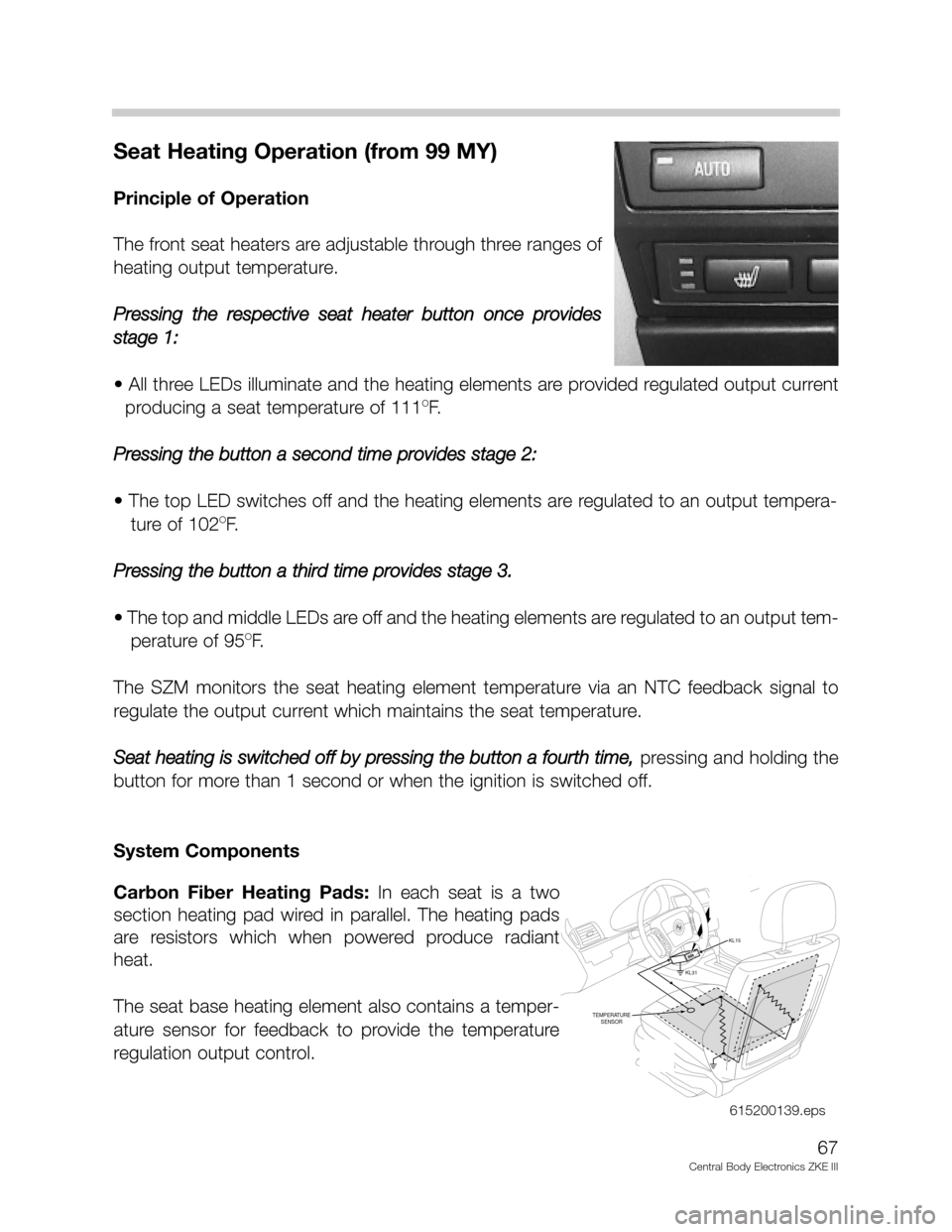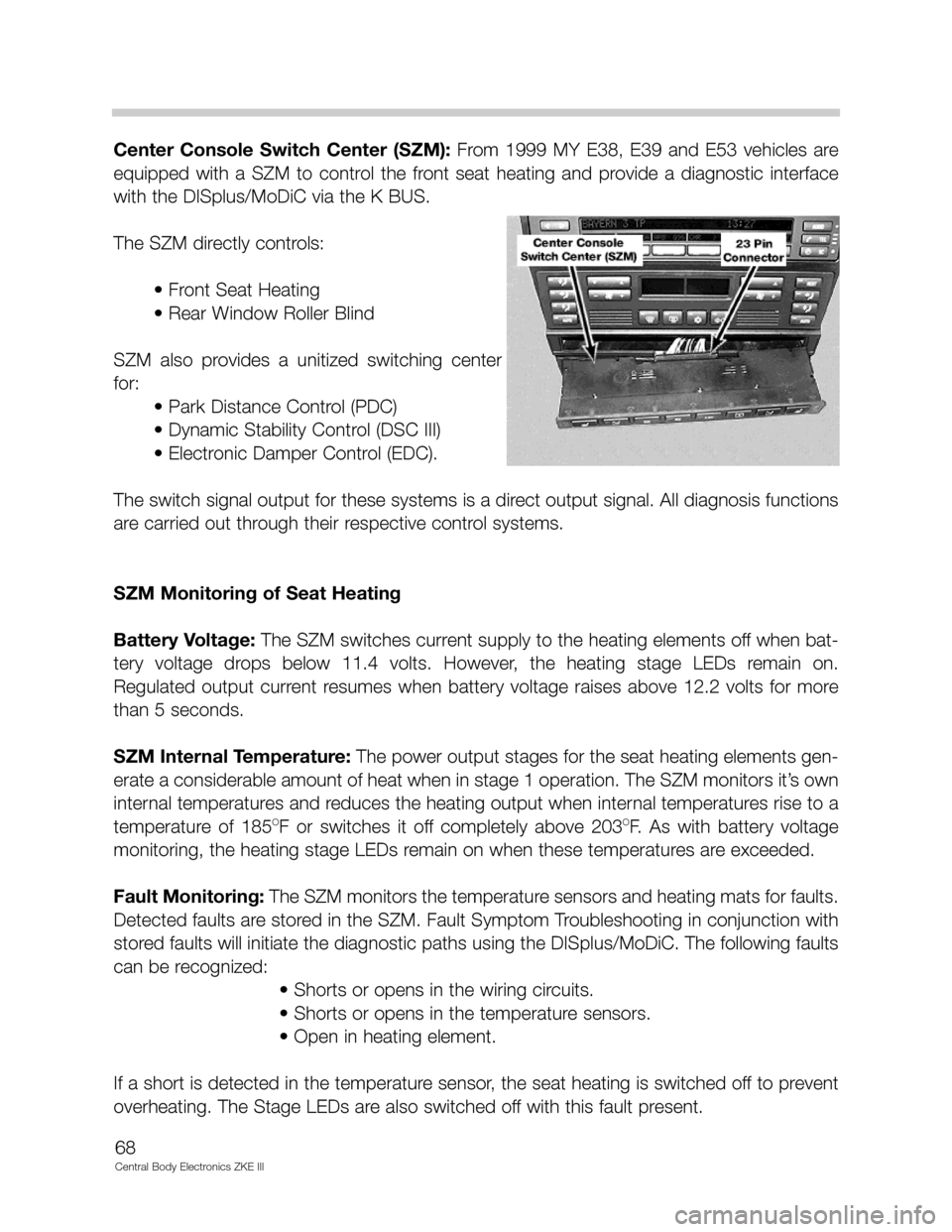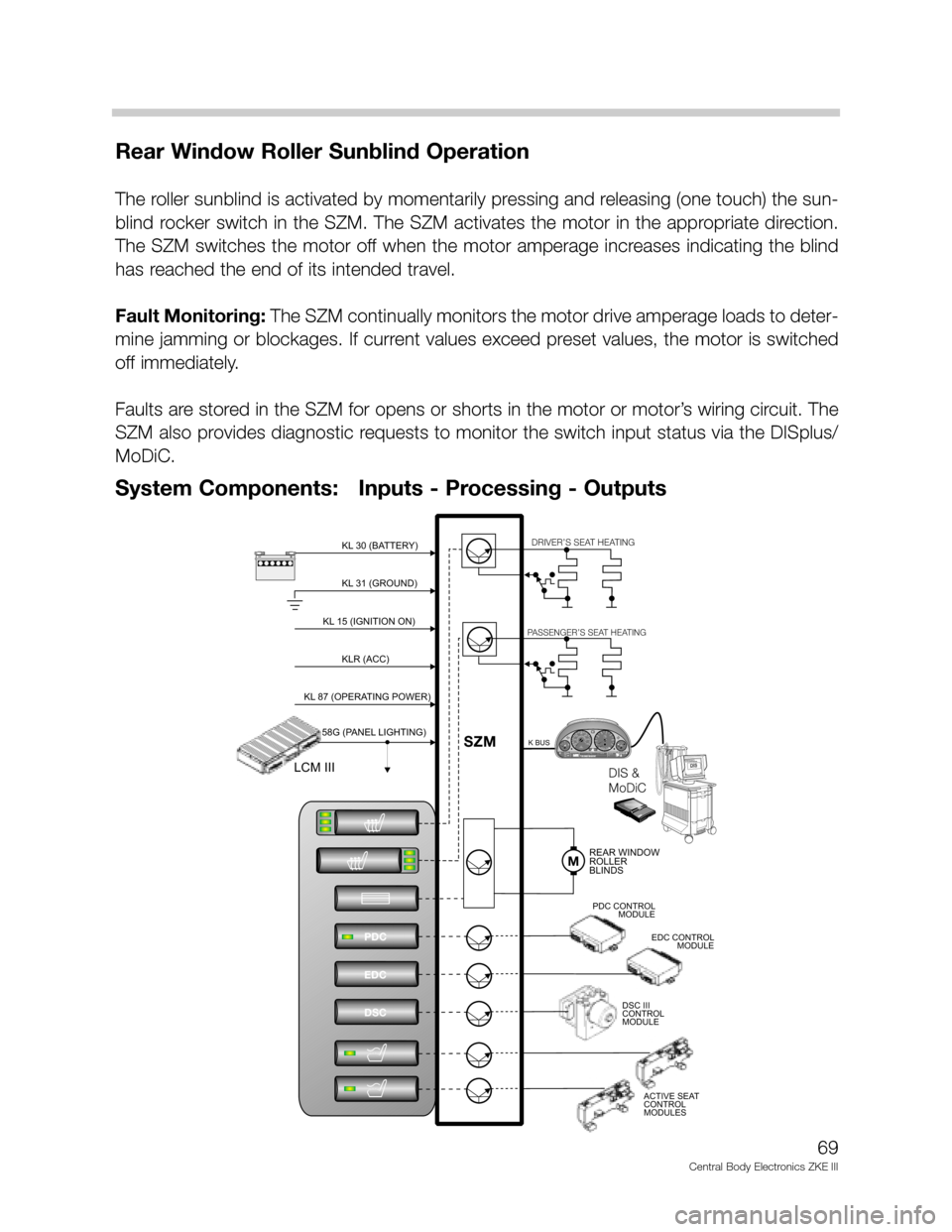1994 BMW 750IL heating
[x] Cancel search: heatingPage 3 of 80

3
Central Body Electronics ZKE III
Central Body Electronics (ZKE III)
Purpose of the System
The Central Body Electronics (ZKE III) system manages the following functions:
GM III
• Windshield Wiping/Washing
• Windsheild Rain Sensor (AIC)
• Headlight Washing
• Tailgate Wiping/Washing
• Interior Lighting
• Central Locking
• Keyless Entry
• Key Memory
• Power Trunk Release
• Electric Opening of Tailgate
• DWA Alarm System
• Servotronics
• Consumer Cut-off/sleep mode
• DiagnosisDriver’s Door Switch Block/
Module
• Power Windows
• Mirror Adjustment/Memory/
HeatingPassenger’s Door Module
• Mirror Adjustment/Memory/
Heating
• Power Windows
Sunroof Module
• Power SunroofSeat/Mirror/ Steering Column
Memory Module
• Seat Adjustment/Memory
• SteeringColumn Adjustment/
Memory
The ZKE III system was introduced on the E38 and is used in the E39 and E53. Most of the
functions operate the same on these vehicles with minor changes and added features to
the system.
ZKE III represents the combination of Body Electronics functions into one central control
module, the General Module (GM).
Page 46 of 80

Power Window Motors: The window motors are mounted on the cable regulators. The
window motor control circuit consists of two wires for operating the motor in both direc-
tions.
The motors are activated by relays in the GM of door
modules (front doors). The relays provide either power
or ground depending on the direction of window travel.
The GM controls the polarity of the motor based on a
request to run the window (window switch,
Convenience Opening/ Closing).
The windows are run to the limit stops which is detect-
ed by an amperage increase in the control circuit.
Additionally, the window run cycle is limited to a 6-8
second duration if in case the amperage increase is not
detected or there is a malfunction with the regulator.
Window Motor Limit Stop Function: If the windows are run up and down continuously
a limit stop function is activated to prevent the window motors from overheating. The GM
monitors the number of times the window motors are activated. Each cycle is counted and
stored in memory.
If the repetitive window activation (up/down) exceeds one minute, the GM deactivates the
internal relays and disregards any further input requests. The GM provides motor activation
after a short duration but not for the full one minute monitoring cycle. Over time, the GM
slowly reverses the stored count of activation until the stored number equals 0.
Convenience Opening/Closing: The GM provides the convenience open/close feature
providing control of the power windows (and sunroof) from outside the vehicle with the key
in the driver’s door lock cylinder. The FZV provides the same function for the opening only.
• The anti-trap feature is active during convenience closing from the driver’s door lock.
• The convenience open feature provides outside activation of the windows and sunroof
in the same manner.
• If the GM receives a request to operate convenience close or open for more than 110
seconds, the function is deactivated and a fault code is stored.
• The Car Memory Feature can activate and deactivate the Convenience Open Feature
from the FZV’s control.
46
Central Body Electronics ZKE III
FRONT DOOR
REGULATOR
615200114.eps
Page 60 of 80

Mirror
Principle of Operation
The output stages and memory storage of mirror positions is handled by the respective
door modules. The positioning of the mirrors is signaled from the driver’s door switch
block/module. The signal passes over the P-Bus to the passenger’s door module.
The memory/recall for the driver’s mirror comes directly into the door module from the
memory switch. The operation for the passenger’s side mirror is carried out over the P-Bus
from the driver’s door module to the passenger’s door module.
The memory positions are stored in each respective module. The memory position is rec-
ognized by the feedback potentiometers located on each mirror motor.
The reverse gear tilt feature for the passenger’s mirror is signaled from the GM, over the P-
bus, when reverse is selected and the mirror switch is set for the driver’s side.
Mirror heating is controlled by each respective door module. The GM receives the outside
temperature from the IKE and passes it to the door modules. The “ON” time for mirror heat-
ing is adjusted based on the outside temperature.
A pulsed heating cycle is used for the mirrors based on the outside temperature.
60
Central Body Electronics ZKE III
Temperature<-10OC -10 to 0OC 0 to 15OC 15 to 25OC >25OC
ON - duration 100% 75% 50% 25% 5%
E39 Shown
Page 67 of 80

67
Central Body Electronics ZKE III
Seat Heating Operation (from 99 MY)
Principle of Operation
The front seat heaters are adjustable through three ranges of
heating output temperature.
Pressing the respective seat heater button once provides
stage 1:
• All three LEDs illuminate and the heating elements are provided regulated output current
producing a seat temperature of 111
OF.
Pressing the button a second time provides stage 2:
• The top LED switches off and the heating elements are regulated to an output tempera-
ture of 102
OF.
Pressing the button a third time provides stage 3.
• The top and middle LEDs are off and the heating elements are regulated to an output tem-
perature of 95
OF.
The SZM monitors the seat heating element temperature via an NTC feedback signal to
regulate the output current which maintains the seat temperature.
Seat heating is switched off by pressing the button a fourth time,
pressing and holding the
button for more than 1 second or when the ignition is switched off.
System Components
Carbon Fiber Heating Pads:In each seat is a two
section heating pad wired in parallel. The heating pads
are resistors which when powered produce radiant
heat.
The seat base heating element also contains a temper-
ature sensor for feedback to provide the temperature
regulation output control.
KL31
KL15
TEMPERATURE
SENSOR
615200139.eps
Page 68 of 80

68
Central Body Electronics ZKE III
Center Console Switch Center (SZM): From 1999 MY E38, E39 and E53 vehicles are
equipped with a SZM to control the front seat heating and provide a diagnostic interface
with the DISplus/MoDiC via the K BUS.
The SZM directly controls:
• Front Seat Heating
• Rear Window Roller Blind
SZM also provides a unitized switching center
for:
• Park Distance Control (PDC)
• Dynamic Stability Control (DSC III)
• Electronic Damper Control (EDC).
The switch signal output for these systems is a direct output signal. All diagnosis functions
are carried out through their respective control systems.
SZM Monitoring of Seat Heating
Battery Voltage:The SZM switches current supply to the heating elements off when bat-
tery voltage drops below 11.4 volts. However, the heating stage LEDs remain on.
Regulated output current resumes when battery voltage raises above 12.2 volts for more
than 5 seconds.
SZM Internal Temperature: The power output stages for the seat heating elements gen-
erate a considerable amount of heat when in stage 1 operation. The SZM monitors it’s own
internal temperatures and reduces the heating output when internal temperatures rise to a
temperature of 185
OF or switches it off completely above 203OF. As with battery voltage
monitoring, the heating stage LEDs remain on when these temperatures are exceeded.
Fault Monitoring:The SZM monitors the temperature sensors and heating mats for faults.
Detected faults are stored in the SZM. Fault Symptom Troubleshooting in conjunction with
stored faults will initiate the diagnostic paths using the DISplus/MoDiC. The following faults
can be recognized:
• Shorts or opens in the wiring circuits.
• Shorts or opens in the temperature sensors.
• Open in heating element.
If a short is detected in the temperature sensor, the seat heating is switched off to prevent
overheating. The Stage LEDs are also switched off with this fault present.
Page 69 of 80

Rear Window Roller Sunblind Operation
The roller sunblind is activated by momentarily pressing and releasing (one touch) the sun-
blind rocker switch in the SZM. The SZM activates the motor in the appropriate direction.
The SZM switches the motor off when the motor amperage increases indicating the blind
has reached the end of its intended travel.
Fault Monitoring: The SZM continually monitors the motor drive amperage loads to deter-
mine jamming or blockages. If current values exceed preset values, the motor is switched
off immediately.
Faults are stored in the SZM for opens or shorts in the motor or motor’s wiring circuit. The
SZM also provides diagnostic requests to monitor the switch input status via the DISplus/
MoDiC.
69
Central Body Electronics ZKE III
KL 31 (GROUND)KL 31 (GROUND)
DIS
DIS
BMWDIS
B
M
WD
I
S
BMWDIS
BMW
DIS
D
ia
g
n
o
s
e
-
a
n
d
In
fo
r
m
a
ti
o
n
S
y
s
t
e
mDIS &
MoDiCDIS &
MoDiC
M
o
Di
C
0½
CHECK
ENGINE
CHECK
ENGINEOIL SERVICEOIL SERVICEINSPECTIONINSPECTIONP
1/min
x1000km/hELECTRONICMPH1
2020404060608080100180160140 1201002001202201402400234
5
6
7!!ABS20 DIGIT READOUT20 DIGIT READOUT
123456
prnd432
m
prnd432
m
122.4 +72.0 fo
+72.0 fomiles0
10
15 20 40
KL 30 (BATTERY)KL 30 (BATTERY)-+
KL 15 (IGNITION ON)KL 15 (IGNITION ON)
KLR (ACC)KLR (ACC)
KL 87 (OPERATING POWER)KL 87 (OPERATING POWER)
58G (PANEL LIGHTING)58G (PANEL LIGHTING)
LCM IIILCM III
PDC
EDC
DSC
MREAR WINDOW
ROLLER
BLINDSREAR WINDOW
ROLLER
BLINDS
DRIVER’S SEAT HEATINGDRIVER’S SEAT HEATING
PASSENGER’S SEAT HEATINGPASSENGER’S SEAT HEATING
K BUSK BUS
PDC CONTROL
MODULEPDC CONTROL
MODULE
EDC CONTROL
MODULEEDC CONTROL
MODULE
SZMSZM
DSC III
CONTROL
MODULEDSC III
CONTROL
MODULE
ACTIVE SEAT
CONTROL
MODULESACTIVE SEAT
CONTROL
MODULES
System Components: Inputs - Processing - Outputs
Page 80 of 80

9. What type of sensor is used to detect the position of a seat with Memory? What type
of signal does it produce?__________________________________________________
_________________________________________________________________________
10. How does the Seat Module communicate a request for a stored memory position with
the mirror modules?_______________________________________________________
________________________________________________________________________
11. On an E38 with Servotronic, why is the speed signal provided to the GM from both
the IKE “A” signal and the K-Bus?___________________________________________
________________________________________________________________________
________________________________________________________________________
12. An E38 customer complains that when exiting the vehicle the steering wheel moves
up. What is the cause of this?______________________________________________
________________________________________________________________________
13. How does the SZM monitor the Seat Heating temperature?_____________________
________________________________________________________________________
________________________________________________________________________
14. What circuits are controlled by Consumer Cut Off? ____________________________
________________________________________________________________________
________________________________________________________________________
15. If a technician double locked a 2000 MY E39 while still inside the vehicle, how could
he/she exit the vehicle?____________________________________________________
________________________________________________________________________
________________________________________________________________________
16. How is the MY 2000 key charged?__________________________________________
________________________________________________________________________
________________________________________________________________________
17. How is the DWA Disarmed (emergency)?_____________________________________
________________________________________________________________________
18. What functions will deactivate the exterior door handle lighting? _________________
________________________________________________________________________
________________________________________________________________________
________________________________________________________________________
80
Central Body Electronics ZKE III